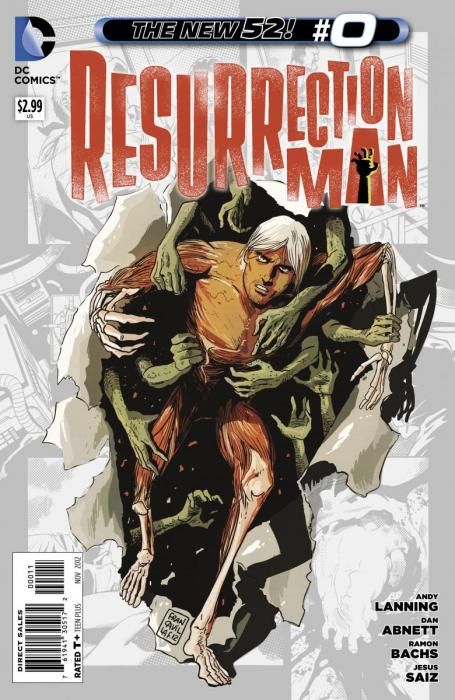In "Resurrection Man" #0, writers Dan Abnett and Andy Lanning and artist Ramon Bach deliver a satisfying origin story and a tidy resolution to the New 52's run of "Resurrection Man." Either by itself is no small feat, but combined make for an applause-worthy exit.
The cliffhanger in "Resurrection Man" #12 was shocking and bizarre, but it's also a standard trope. Is Hooker's boss really who he claims to be and if so, how is that possible? Was it just for shock value or is there a story with substance to account for everything? Luckily for readers, it's the latter, and "Resurrection Man" #0 explains all with a few clever twists. There's a lot of scientific-sounding fantasy, but "Resurrection Man" lives in a bizarre mash of angels and demons and labs anyway. The wrap-up is a little too neat, but it comes off because Abnett and Lanning have laid the groundwork for it earlier.
Half the issue is told in flashback, and Abnett and Lanning use dialogue and action to give the past the immediacy of the present. The action returns to the present halfway through the issue when Mitch Shelley deals with difficult revelations about his past and origin admirably. When Mitch says, "This is the truth I was looking for," facing ugly facts without a hint of denial, he is his finest, most heroic self and the confrontation that immediately follows is poignant and larger than life as he accepts one truth, but then turns from it to embrace greater truths about who and what he is.
"Resurrection Man" #0 taps into an archetypal idea about the soul by shining a limelight on the contrast between the old Mitch Shelley in Iraq and the Mitch Shelley readers have come to know. The idea of a Double is a classic plot device that invokes literary themes about appearance and identity, the Self and the Other. Abnett and Lanning use this device to show Mitch's growth towards self-knowledge and reinforce it with the background battle for Mitch's soul between an angel and a demon.
Artist Ramon Bachs does a great job with these fast-paced, psychologically tense action scenes. His detailed double-page spread in the jungle gives those quieter pages due atmosphere and weight. Also, his transitions keep the timeline and battle participants clear. Jeromy Cox's colors are too bright and fluorescent, but they don't detract from Bach's clear storytelling. Jesus Saiz handles the last page of art. The change in art style was clear enough that I noticed it while reading, but it didn't disturb the flow of the story much.
Bachs' costuming also felt on the mark. It seems appropriate rather than gratuitous that Mitch would be naked to "face the truth." The Body Doubles, in contrast, wear slick "Men in Black"-style suits and ties and then body armor. While that deviates from their naughty schoolgirl, "Dirty Pair"-style origins, it's nice to see killers and soldiers dressed appropriately for the occasion: professional mayhem and violence. Miss Manners would approve. The two also provide comic relief, and their bouncy camaraderie makes them an endearing pair despite their cavalier ethics.
Abnett and Lanning never take "Resurrection Man" too seriously, and their offbeat humor further distinguishes this misfit fantasy/scifi/horror title. The "bad" guy gets the best lines, of course, as well as the final word. The demon is still unnamed at the end of "Resurrection Man," even though he is a cunning scene-stealer. His line, "Relax, woman. I just did a bit of demon-y magic stuff" made me laugh aloud, and "Resurrection Man" #0 ends on a perfect, lighthearted note, promising that it is "[Never Ever] The End."

